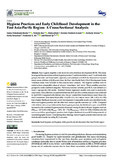| dc.contributor.author | Rocha, Fanny Petermann | |
| dc.contributor.author | Rao, Nirmala | |
| dc.contributor.author | Bala, Manya | |
| dc.contributor.author | Asnani, Monika Parshad | |
| dc.contributor.author | Sifuna, Anthony | |
| dc.contributor.author | Aisha, Yousafzai | |
| dc.contributor.author | Ho, Frederick K. | |
| dc.contributor.author | Ip, Patrick | |
| dc.date.accessioned | 2023-04-24T06:53:34Z | |
| dc.date.available | 2023-04-24T06:53:34Z | |
| dc.date.issued | 2023-02-04 | |
| dc.identifier.uri | https://doi.org/10.3390/ijerph20042798 | |
| dc.identifier.uri | https://www.mdpi.com/1660-4601/20/4/2798 | |
| dc.identifier.uri | http://ir-library.mmust.ac.ke:8080/xmlui/handle/123456789/2168 | |
| dc.description.abstract | Poor hygiene might be a risk factor for early childhood development (ECD). This study investigated the associations of three hygiene practices (‘wash hands before a meal,’ ‘wash hands after going to the toilet,’ and ‘brush teeth’), separately and combined, with ECD. Six thousand six hundred ninety-seven children (4 [0.8] years) from the East Asia-Pacific Early Child Development Scales validation study were included in this cross-sectional analysis. The hygiene variables were recoded to have comparable values as ‘always,’ ‘sometimes,’ and ‘never.’ These variables were then grouped to create combined categories. The binary outcome variables, poor ECD, were defined as a score < age-specific 25th centile. Modified Poisson regression models were used to analyse the associations. Data collection was performed between 2012 and 2014, and the analyses were conducted in April 2022. Compared with children who ‘always’ washed their hands before a meal, those who did it ‘sometimes’ (Prevalence Ratio [PR]: 1.30 [95% CI: 1.16–1.46]) or ‘never’ (PR: 1.35 [1.18–1.55]) had a higher likelihood of poorer overall development. Comparable results were identified for the other two hygiene practices and the other four domain-specific outcomes (p < 0.05). Compared with children who always followed the three hygiene practices, the likelihood of poor overall ECD increased as the combined hygiene practice decreased among children with poor hygiene practices (PRnever: 1.67 [1.40–2.00]; PRrarely: 1.49 [1.30–1.71]; PRsometimes: 1.30 [1.14–1.49]). Children who did not always follow good hygiene practices had a higher likelihood of poor ECD independently of sociodemographic factors. Considering these findings, future hygiene practice interventions and trials should consider including ECD outcome | en_US |
| dc.language.iso | en | en_US |
| dc.publisher | Internatiuonal Journal of Environmental Research and Public Health | en_US |
| dc.subject | Hygiene Practices, Early Childhood, Development, the East Asia-Pacific Region, A Cross-Sectional, Analysis | en_US |
| dc.title | Hygiene Practices and Early Childhood Development in the East Asia-Pacific Region: A Cross-Sectional Analysis | en_US |
| dc.type | Article | en_US |

